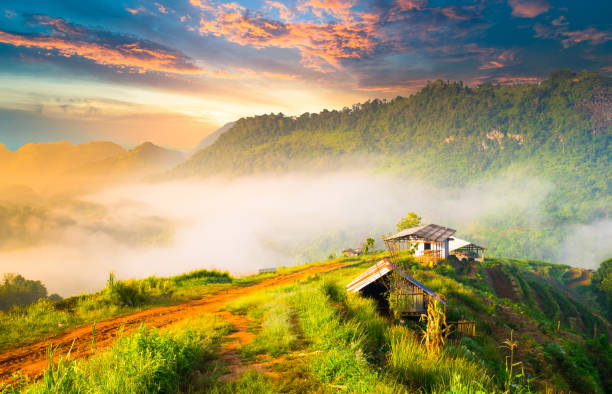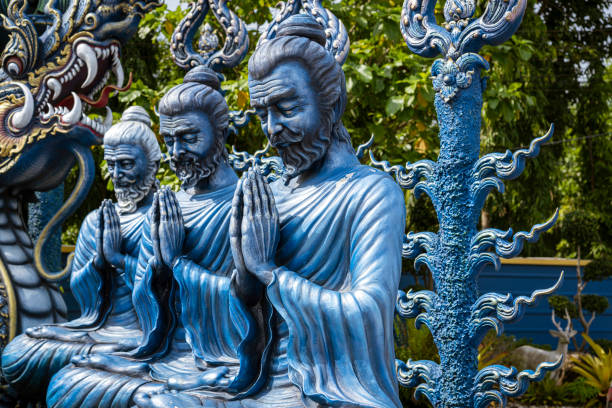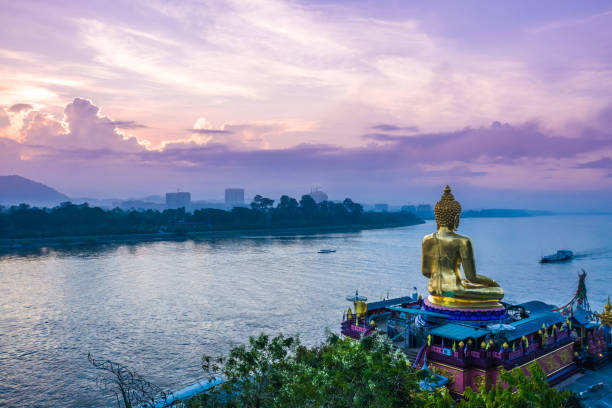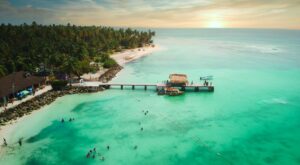
Panoramic view Sunrise and mist on mountain view at the north of thailand
Beyond the bustling streets of Bangkok and the pristine beaches of the South, a trip to Chiang Rai unveils a facet of Thailand often overlooked by mainstream travellers. Nestled in the verdant highlands, the indigenous hill tribes of Chiang Rai provide a captivating blend of cultures, traditions, and histories, making it one of the must-visit places in Thailand Tour Packages for those keen on an enriching journey.
Understanding Chiang Rai’s Hill Tribes
There are several tribes residing in this region, each with their own distinct languages, attire, and customs:
- Akha: Recognised by their intricate headdresses, the Akha have a rich oral tradition, with festivals and rituals playing a pivotal role in their community.
- Lisu: Dangling between Myanmar and Thailand, the Lisu tribe boasts vibrant costumes and a distinctive musical heritage.
- Karen: Some Karen women are often called ‘long-necks’ because of the brass coils they wear, a unique cultural symbol.
Merging Tribal Visits into Thailand Tour Packages
A trip to Chiang Rai can be more than just a visual feast; it’s a rendezvous with ancient customs:
- Tribal Homestays: Immerse yourself by spending a night or two in a tribal village. It offers an unparalleled insight into their day-to-day life.
- Craft Workshops: Learn traditional weaving, beadwork, or even the nuances of tribal music by joining hands-on workshops.
- Local Markets: Explore markets like Mae Salong where tribes people sell handmade artefacts, offering a chance to take home a piece of their artistry.

The Enigmatic Allure of Chiang Rai’s Landscape
Venturing into Chiang Rai isn’t just about its fascinating tribes; it’s also a voyage into some of Thailand’s most mesmerizing landscapes. Beyond the tribal villages, the region offers a tapestry of natural wonders and historical sites that are a testament to the rich tapestry of Northern Thailand.
Golden Temples & Contemporary Art
While the hill tribes might be the centerpiece of a trip to Chiang Rai, the region’s temples and art installations add layers to its allure:
- Wat Rong Khun (The White Temple): A masterpiece in its own right, this contemporary temple is an artistic expression of Buddhist teachings. Its shimmering white structure, adorned with mirrors and intricate sculptures, represents purity and offers a stark contrast to traditional Thai temples.
- Baan Dam (Black House): This complex, crafted by Thai artist Thawan Duchanee, is a fascinating amalgamation of art, architecture, and surrealism. A series of dark wooden structures interspersed with animal bones and skins, it offers a thought-provoking counter to the White Temple’s ethereal aura.
Natural Resplendence & Adventure
For nature enthusiasts, Chiang Rai does not disappoint:
- Phu Chi Fah: This mountaintop viewpoint is a haven for sunrise seekers. Standing here, with the mist-covered hills stretching out beneath, one feels on top of the world.
- Khun Korn Waterfall: Dangling amidst thick jungle, the 70-meter cascade offers a refreshing retreat. The trek to the waterfall itself is a delightful journey through Chiang Rai’s lush landscape.
- Golden Triangle: Where Thailand meets Laos and Myanmar, the Golden Triangle is steeped in history, once notorious for its opium trade. Today, it’s a place of serene boat rides on the Mekong River and views across three nations.

Festivals & Cultural Immersion
Deepening your cultural experience, Chiang Rai’s calendar is dotted with festivals that showcase its vibrant heritage:
- Wai Sa Phaya Mengrai (King Mengrai Festival): Celebrated in January, it pays homage to King Mengrai, the founder of Chiang Rai. The city comes alive with parades, cultural performances, and a carnival atmosphere.
- Songkran: While celebrated throughout Thailand, Chiang Rai’s Songkran has its own unique flair. From the traditional water fights to the Miss Songkran beauty contest, it’s an experience that blends tradition with festivity.
Local Culinary Delights
No exploration is complete without diving into the local culinary scene:
- Khao Soi: This Northern Thai curry noodle soup, a blend of Burmese and Thai influences, is a must-try. Creamy, spicy, and utterly delectable, it embodies the region’s rich culinary heritage.
- Sai Oua: A Northern Thai sausage bursting with flavours from a medley of herbs and spices, it’s often paired with sticky rice, making for a delightful local snack.
Travel Tips Extended for an Enriched Experience
Expanding on our travel tips:
- Rent a Scooter: Chiang Rai’s landscapes are best explored at your own pace. Renting a scooter offers flexibility, allowing you to meander through the countryside, discover hidden gems, and truly immerse in the region’s beauty.
- Stay Connected: Some remote areas might have patchy mobile networks. Keeping an offline map and informing your accommodation of your plans is advisable.
- Engage in Conversations: Locals in Chiang Rai are incredibly friendly. Engaging in conversations not only enhances your experience but often leads to discovering lesser-known spots.
Travel Tips for Chiang Rai’s Tribal Regions
When planning a cultural trip to Chiang Rai, remember:
- Respect is Paramount: Always ask permission before taking photos. Understand that you’re in their home, and being respectful is essential.
- Dress Modestly: While Thailand can be hot, it’s important to dress conservatively, especially when visiting tribal regions.
- Employ Local Guides: They not only provide invaluable insights but also bridge any language or cultural barriers.
- Tread Lightly: Remember to minimize your ecological footprint. Stick to designated paths and avoid disrupting the natural surroundings.
- Buy Authentic Souvenirs: Support the local economy by purchasing crafts directly from artisans, ensuring your money supports the community.
To Wrap it Up:
Chiang Rai, with its indigenous tribes, awe-inspiring landscapes, historical sites, and rich cultural tapestry, beckons travellers seeking depth in their adventures. As you fine-tune your Thailand tour packages, ensuring a substantial segment dedicated to Chiang Rai can offer experiences that are both soulful and unforgettable. In this Northern gem, every path leads to discovery, and every moment is a step closer to the heart of Thai culture. Safe travels!
Note: Always research ahead and opt for sustainable travel options, ensuring your visit benefits the local communities. Safe and respectful travels!
Frequently Asked Questions (FAQs) about Merging Cultural Tours in Your Chiang Rai Adventure
1. How can I incorporate a tribal visit in my Thailand tour packages?
When you’re tailoring your Thailand tour packages, many travel agencies offer specific cultural excursions to Chiang Rai’s hill tribes. Always ensure to choose a package that promotes responsible tourism, benefiting both visitors and the local communities.
2. I’ve heard a lot about Chiang Mai. How different is a trip to Chiang Rai?
While both are stunning Northern cities in Thailand, a trip to Chiang Rai tends to be less commercialized than Chiang Mai. Chiang Rai offers a deeper dive into indigenous tribal cultures and boasts unique attractions like the White Temple and Black House.
3. Are there any specific places to visit in Thailand near Chiang Rai after my tribal tour?
Absolutely! Beyond the hill tribes, Chiang Rai is home to mesmerizing temples like Wat Rong Khun and art spaces like Baan Dam. Nature lovers can explore Phu Chi Fah and Khun Korn Waterfall, while those interested in history shouldn’t miss the Golden Triangle.
4. Can I combine both mainstream and offbeat destinations in my Thailand tour packages?
Yes, many travellers mix and match. You can start with the bustling vibe of Bangkok, relax on the beaches of Phuket, and then head north for a culturally enriching trip to Chiang Rai, ensuring a wholesome Thai experience.
5. Is it easy to find local guides for a trip to Chiang Rai’s tribal regions?
Indeed. There are plenty of experienced local guides who can enhance your trip to Chiang Rai with their knowledge and insights. Including a guided tour in your Thailand tour packages ensures a deeper understanding of the tribal cultures and traditions.
Read more : Food Tours in Thailand’s Southern Hub



